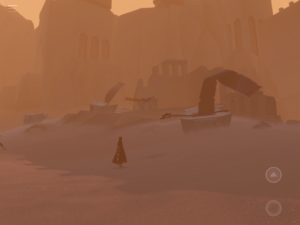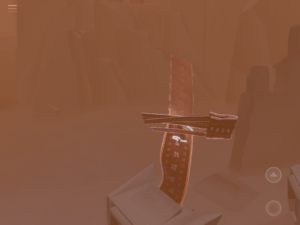I played the game Journey for this assignment. Journey is an adventure game developed by Thatgamecompany, and published by Sony Computer Entertainment. I could not find specific information about Journey’s target audience; however, the game appeals to a broad audience that includes casual gamers, art and music lovers, fans of indie games, or even players seeking emotional experiences. It was released in 2012, and is available on multiple platforms: PlayStation 4, PlayStation 3, iOS and Microsoft Windows. For this assignment, I had a wonderful time playing Journey on my iPad.
In Journey, walking pushes players to tap into their sense of observation in order to uncover the underlying story. Journey does not offer any instructions or guidance to its players, nor does it contain a map that helps players navigate the game’s environment. Instead, Journey players rely solely on walking to figure out how to proceed to the next step in the game, which forces them to use their sense of observation and their deduction skills (Figure 1). A great example from my experience playing the game is that, at one point, I kept walking in the wrong direction, thinking that I needed to follow a comet that I saw. The game sent strong winds my way in order to steer me in the right direction. After a couple of attempts, I deduced that the winds were not an obstacle that I needed to brave, but rather a sign that I should be walking the opposite way. Journey uses the walking mechanic to push the player into various scenarios that require observation and deductive reasoning, two dynamics that in turn equip the player to uncover the story.
While walking tells the story by encouraging dynamics such as observation and deductive reasoning, it’s important to note that, in doing so, it satisfies specific psychogenic needs that keep the players engaged in this embedded narrative. It is clear that Journey developers had a solid grasp of players’ need for cognizance and understanding when they created the game. Journey players walk to explore their environment and understand information about it on their own; every time they are able to discover a new part of the story, they are more engaged in the game and want to keep playing in order to know more (Figure 2). In Journey, walking goes beyond engaging users in the game’s story to make users feel like the story is their own.
To summarize, Journey leverages its walking mechanic not just as a mode of movement, but as a profound narrative device. Walking invites players into a world where their sense of observation and deductive reasoning are continually challenged and rewarded. My personal gameplay experience helped me see that Journey fosters a unique explorative experience. In Journey, each step taken not only advances the player through the game’s stunning environment but also deeper into a story that feels intimately personal. By fulfilling inherent psychogenic needs for cognition and exploration, Journey ensures that each player finds enlightenment along their voyage. Thus, Journey stands out as a masterful blend of art, emotion, and engagement.





